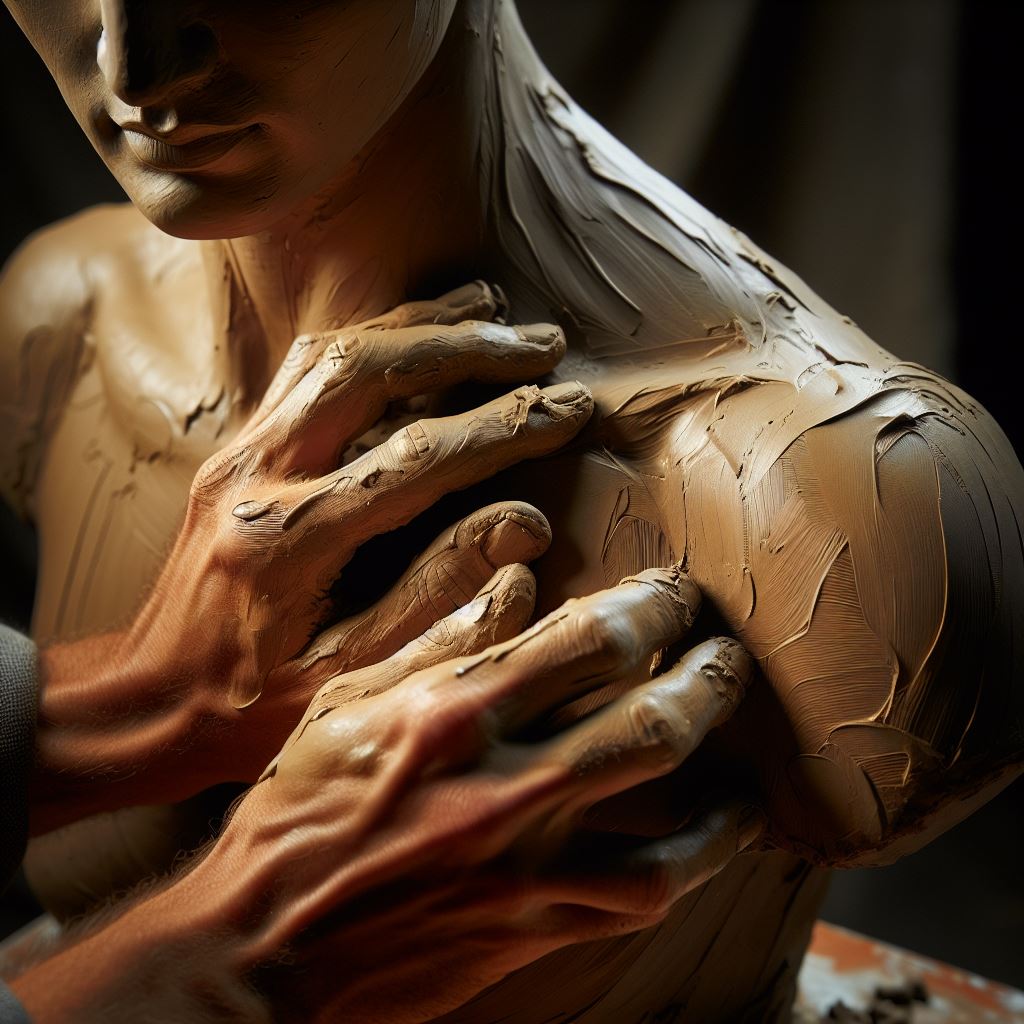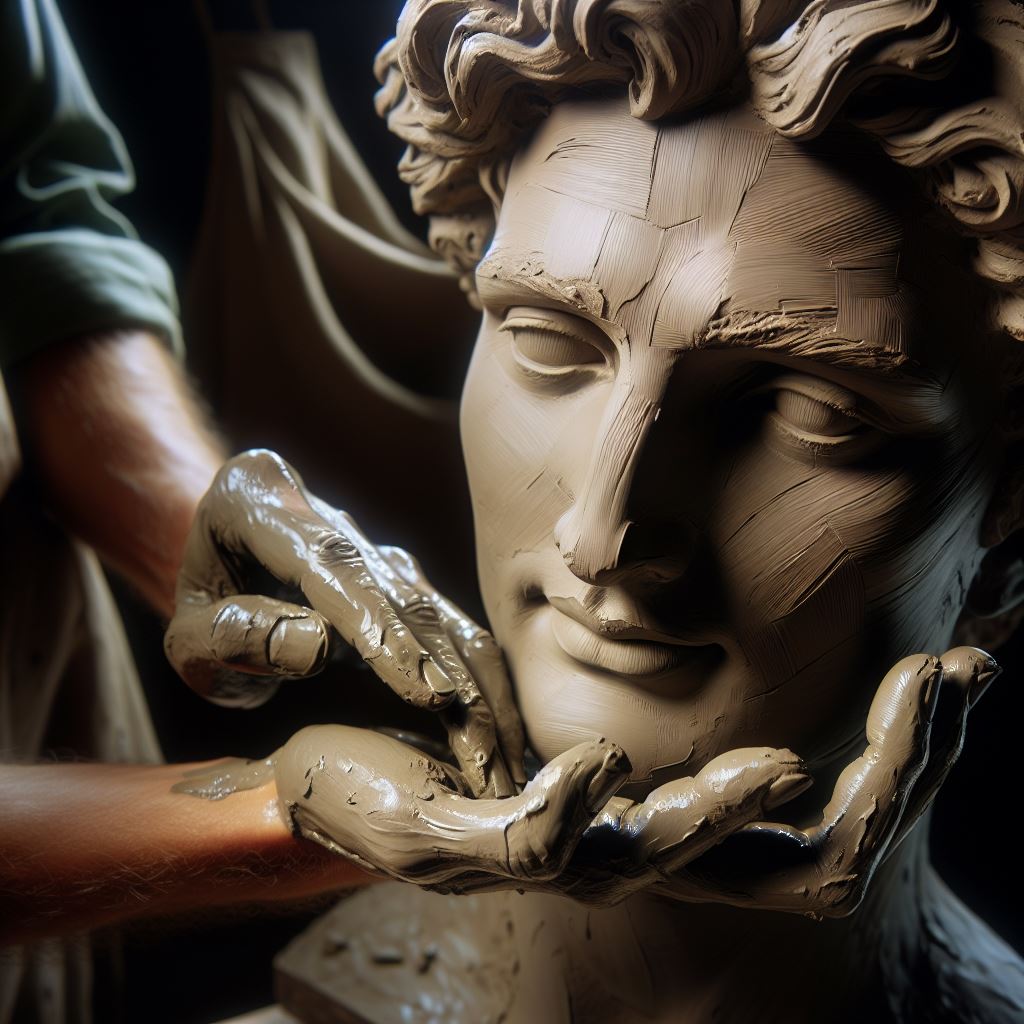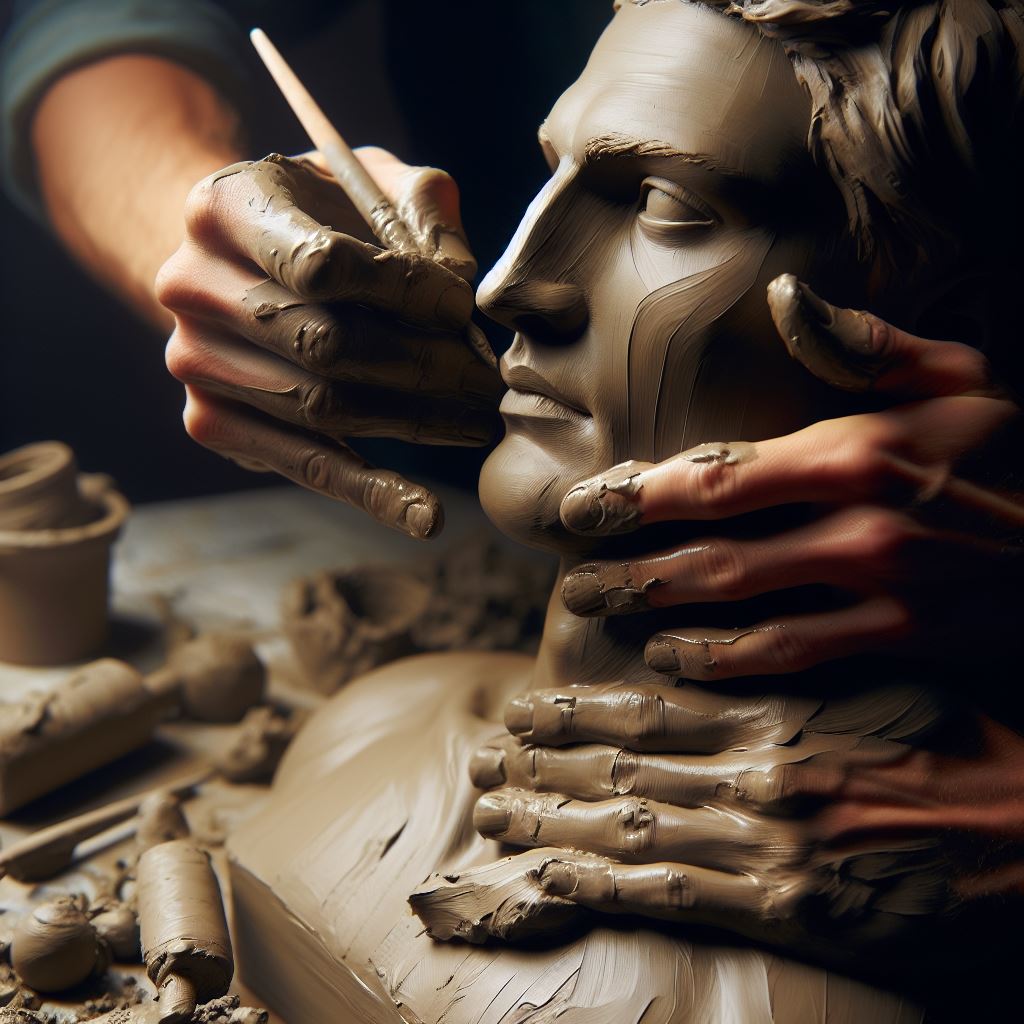Table Of Contents
- 1 Sculpting with Patina and Glazing Techniques: A Guide to Enhancing Your Sculptures
- 1.1 What are Patinas and Glazes?
- 1.2 The Benefits of Using Patinas and Glazes
- 1.3 Incorporating Patinas and Glazes into Your Sculpting Process
- 1.4 Exploring Creative Possibilities
- 1.5 Sculpting with Patina and Glazing Techniques: Delving into the Details
- 1.6 Patinas: Unveiling the Alchemy of Aging
- 1.7 Verdigris: The Emerald Messenger of Time
- 1.8 Rust Patina: The Rustic Charm of Aged Iron
- 1.9 Fire Patina: The Dance of Flame and Metal
- 1.10 Glazes: The Glassy Guardians of Sculptures
- 1.11 Transparent Glazes: Unveiling the Natural Beauty
- 1.12 Opaque Glazes: A Canvas for Artistic Expression
- 1.13 Semi-Opaque Glazes: A Harmonious Blend of Light and Color
- 1.14 Sculpting with Patina and Glazing Techniques: A Journey of Artistic Expression
- 1.15 Preparing Your Canvas: The Bisque Firing
- 1.16 The Art of Patina Application: Unleashing the Power of Chemistry
- 1.17 The Enchanting Transformation of Glazes: From Powder to Glass
- 1.18 The Final Touches: Sealing and Protection
- 1.19 Exploring Creative Possibilities: Unleashing Your Artistic Vision
- 1.20 Sculpting with Patina and Glazing Techniques: A Comprehensive Guide
- 1.21 Patinas: The Chemical Alchemists of Sculpture
- 1.22 Application Methods:
- 1.23 Common Patinas:
- 1.24 Glazes: The Vitreous Guardians of Sculptures
- 1.25 Glaze Types:
- 1.26 Firing Temperatures:
- 1.27 Practical Tips for Successful Patina and Glaze Application:
- 1.28 Conclusion:
Sculpting with Patina and Glazing Techniques: A Guide to Enhancing Your Sculptures

The art of sculpting has captivated humanity for centuries, allowing us to capture the essence of human form, nature, and abstract concepts. While traditional sculpting techniques emphasize form and texture, the application of patinas and glazes elevates these creations to a whole new level of artistic expression.
What are Patinas and Glazes?
Patinas are chemical treatments that alter the color and texture of a sculpture, often resulting in a weathered or aged appearance. They are typically applied to metal sculptures, but they can also be used on ceramics and other materials. Common patinas include verdigris (green patina), rust patina (brown patina), and fire patina (a combination of colors created through controlled oxidation).
Glazes, on the other hand, are vitreous coatings that are applied to sculptures, primarily ceramics, to create a smooth, shiny surface. They come in a wide range of colors and can be transparent, opaque, or semi-opaque. Glazes not only enhance the aesthetic appeal of sculptures but also protect them from moisture and damage.
The Benefits of Using Patinas and Glazes
Incorporating patinas and glazes into your sculpting repertoire offers a multitude of benefits:
-
Enhanced Visual Appeal: Patinas and glazes add depth, dimension, and visual interest to sculptures, bringing them to life with a sense of realism and sophistication.
-
Varied Artistic Effects: The vast array of patinas and glazes available allows sculptors to achieve a wide range of artistic effects, from mimicking natural aging to creating vibrant, eye-catching designs.
-
Protective Barrier: Glazes provide a protective layer that shields sculptures from moisture, dust, and other environmental factors, ensuring their longevity and preservation.
-
Versatility: Patinas and glazes can be applied to various sculpting materials, including metal, ceramic, and even wood, expanding your artistic possibilities.
Incorporating Patinas and Glazes into Your Sculpting Process
To effectively utilize patinas and glazes in your sculpting journey, consider these steps:
-
Preparation: Ensure your sculpture is properly bisque fired to create a stable base for the patina or glaze application.
-
Patina Application: Apply patinas using various methods, such as dipping, brushing, or spraying, depending on the desired effect. Allow the patina to react with the sculpture material before sealing or firing.
-
Glaze Application: Apply glazes evenly to the bisque-fired sculpture, ensuring consistent coverage. Multiple layers may be required to achieve the desired color and opacity.
-
Firing: Fire the glazed sculpture to the appropriate temperature according to the glaze type. This process vitrifies the glaze, creating a durable, glassy finish.
-
Sealing: For patinas, apply a sealant to protect the finish and enhance its durability.
Exploring Creative Possibilities
The world of patinas and glazes offers endless creative possibilities. Experiment with different combinations of materials, techniques, and firing temperatures to discover unique textures, color variations, and artistic effects.
Sculpting with Patina and Glazing Techniques: Delving into the Details

In the first session, we explored the captivating world of sculpting with patinas and glazes, highlighting their transformative power to enhance the aesthetic appeal and longevity of sculptures. Now, let’s delve deeper into the intricacies of these techniques, unraveling their mechanisms and applications.
Patinas: Unveiling the Alchemy of Aging
Patinas, the chemical sorcerers of the sculpting realm, possess the remarkable ability to transform sculptures into weathered relics, imbued with the passage of time. Their transformative power stems from their interaction with the sculpture’s material, creating a unique and enduring patina.
Verdigris: The Emerald Messenger of Time
Verdigris, the iconic green patina, graces copper sculptures with an aura of antiquity. This mesmerizing transformation occurs when copper reacts with acetic acid, often present in the atmosphere or applied intentionally. The resulting verdigris layer varies in hue from delicate turquoise to deep emerald, depending on the environmental conditions and the copper’s purity.
Rust Patina: The Rustic Charm of Aged Iron
Rust patina, the russet storyteller of the sculpting world, imparts a rustic charm to iron sculptures, evoking a sense of history and weathered beauty. This transformation arises from the oxidation of iron, creating a range of earthy tones, from warm ochre to deep brick red.
Fire Patina: The Dance of Flame and Metal
Fire patina, the maestro of color alchemy, orchestrates a mesmerizing dance of flame and metal, resulting in captivating multi-hued patinas. This intricate process involves controlled oxidation of the metal surface, producing a spectrum of colors, from iridescent blues and greens to fiery oranges and yellows.
Glazes: The Glassy Guardians of Sculptures
Glazes, the vitreous guardians of sculptures, encase them in a protective layer of shimmering glass, enhancing their beauty and resilience. Their transformation occurs during firing, where the glaze’s powdered constituents melt and fuse onto the sculpture’s surface, creating a smooth, glassy finish.
Transparent Glazes: Unveiling the Natural Beauty
Transparent glazes, the subtle storytellers of form, allow the natural beauty of the underlying sculpture to shine through, adding depth and dimension without obscuring the intricate details. These delicate veils of glass enhance the sculpture’s texture and color, accentuating its intrinsic beauty.
Opaque Glazes: A Canvas for Artistic Expression
Opaque glazes, the bold storytellers of color, transform sculptures into vibrant canvases, showcasing a spectrum of hues and patterns. These versatile glazes provide complete coverage, allowing sculptors to unleash their creativity and craft intricate designs or apply bold, uniform colors.
Semi-Opaque Glazes: A Harmonious Blend of Light and Color
Semi-opaque glazes, the harmonious mediators of light and color, strike a balance between transparency and opacity, allowing a glimpse of the underlying sculpture while simultaneously introducing a range of colors and textures. These versatile glazes offer artistic control over the level of light transmission, creating subtle variations in depth and dimension.
Sculpting with Patina and Glazing Techniques: A Journey of Artistic Expression
Now, let’s embark on a journey through the creative process, exploring the steps involved in incorporating these techniques into your sculpting repertoire.
Preparing Your Canvas: The Bisque Firing
Before embarking on the transformative journey of patina and glaze application, your sculpture must undergo a crucial step: bisque firing. Bisque firing involves heating the sculpted piece to a temperature between 1800 and 2000 degrees Fahrenheit, creating a stable base for the patina or glaze application. This initial firing removes any moisture from the clay, hardens the structure, and prepares the surface for the subsequent transformative processes.

The Art of Patina Application: Unleashing the Power of Chemistry
Patinas, the chemical sorcerers of the sculpting world, demand a careful dance between artistry and scientific precision. The application method depends on the desired effect and the type of patina. Dipping involves immersing the sculpture in a patina solution, while brushing allows for more controlled application. Spraying, on the other hand, offers a delicate mist of patina, creating a subtle and textured finish.
Once the patina has been applied, allow it to react with the sculpture’s material. This reaction time varies depending on the type of patina and the desired effect. For instance, verdigris formation on copper can take several days, while rust patina formation on iron may occur within hours.
The Enchanting Transformation of Glazes: From Powder to Glass
Glazes, the vitreous guardians of sculptures, undergo a remarkable transformation during the firing process. The powdered glaze constituents, a blend of minerals and silica, melt and fuse onto the bisque-fired sculpture’s surface. This fusion creates a smooth, glassy layer, enhancing the sculpture’s aesthetic appeal and providing a protective barrier against moisture and damage.
The firing temperature for glazed sculptures varies depending on the glaze type. Low-fire glazes typically require temperatures between 1800 and 2000 degrees Fahrenheit, while high-fire glazes demand higher temperatures, ranging from 2100 to 2300 degrees Fahrenheit.
The Final Touches: Sealing and Protection
After the firing process, patinated sculptures may require sealing to enhance the finish and protect the patina from environmental degradation. Sealants come in various forms, including waxes, lacquers, and resins. Choose a sealant that is compatible with the patina and complements the desired aesthetic.
For glazed sculptures, the firing process itself vitrifies the glaze, creating a durable, glassy finish. However, some glazes may benefit from additional protection, such as a wax coating, to prevent scratches or abrasion.
Exploring Creative Possibilities: Unleashing Your Artistic Vision
The world of patinas and glazes is a realm of boundless creativity, offering endless possibilities to experiment and express your artistic vision. Explore different combinations of patinas and glazes, experiment with layering techniques, and venture into unconventional firing methods to uncover unique textures, color variations, and artistic effects.
Sculpting with Patina and Glazing Techniques: A Comprehensive Guide
In the previous sessions, we delved into the captivating world of sculpting with patinas and glazes, exploring their transformative power to enhance the aesthetic appeal and longevity of sculptures. Now, let’s conclude our journey with a comprehensive guide that summarizes the key aspects of these techniques, providing insights into their applications and offering practical tips for achieving desired effects.
Patinas: The Chemical Alchemists of Sculpture
Patinas, the chemical alchemists of the sculpting realm, impart a sense of antiquity and weathered beauty to sculptures, transforming them into captivating relics of time. Their transformative power stems from their interaction with the sculpture’s material, creating a unique and enduring patina.
Application Methods:
-
Dipping: Immerse the sculpture in a patina solution for even coverage.
-
Brushing: Apply patina with a brush for controlled application and detailed work.
-
Spraying: Create a delicate mist of patina for subtle and textured effects.
Common Patinas:
-
Verdigris: A mesmerizing green patina formed on copper through interaction with acetic acid.
-
Rust Patina: A russet-colored patina created by the oxidation of iron, evoking a sense of history and weathered charm.
-
Fire Patina: A captivating multi-hued patina produced through controlled oxidation of metal, resulting in a spectrum of colors from blues and greens to oranges and yellows.
Glazes: The Vitreous Guardians of Sculptures

Glazes, the vitreous guardians of sculptures, encase them in a protective layer of shimmering glass, enhancing their beauty and resilience. Their transformation occurs during firing, where the glaze’s powdered constituents melt and fuse onto the sculpture’s surface, creating a smooth, glassy finish.
Glaze Types:
-
Transparent Glazes: Allow the natural beauty of the underlying sculpture to shine through, adding depth and dimension without obscuring intricate details.
-
Opaque Glazes: Transform sculptures into vibrant canvases, showcasing a spectrum of hues and patterns, providing complete coverage for bold, uniform colors.
-
Semi-Opaque Glazes: Strike a balance between transparency and opacity, offering artistic control over the level of light transmission, creating subtle variations in depth and dimension.
Firing Temperatures:
-
Low-Fire Glazes: Typically require temperatures between 1800 and 2000 degrees Fahrenheit.
-
High-Fire Glazes: Demand higher temperatures, ranging from 2100 to 2300 degrees Fahrenheit.
Practical Tips for Successful Patina and Glaze Application:
-
Ensure Proper Bisque Firing: Bisque fire the sculpture to a stable base for patina or glaze application.
-
Choose Compatible Patinas and Glazes: Select patinas and glazes that are compatible with the sculpture’s material.
-
Apply Patinas Evenly: Use consistent application techniques to achieve uniform coverage.
-
Control Glaze Thickness: Apply glazes in thin, even layers to prevent cracking or bubbling during firing.
-
Experiment with Firing Techniques: Explore different firing temperatures and cycles to achieve desired effects.
-
Seal Patinas for Protection: Apply a sealant compatible with the patina to enhance the finish and protect it from degradation.
-
Practice Patience: Allow patinas to react fully and glazes to cool completely before proceeding to the next step.
-
Seek Guidance: Consult experienced sculptors or glaze experts for advice and troubleshooting.
Conclusion:
Sculpting with patinas and glazes is a journey of artistic transformation, where you have the power to elevate ordinary sculptures into captivating masterpieces. Embrace the versatility of these techniques, unleash your imagination, and embark on a creative odyssey that will leave an indelible mark on the world of sculpture. Remember, the key to success lies in experimentation, patience, and a passion for exploring the endless possibilities that these techniques offer.